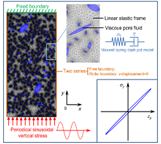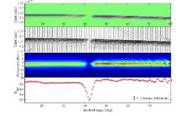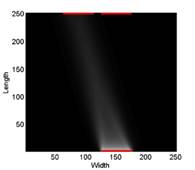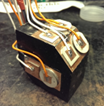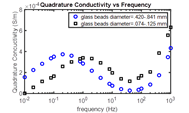The Experimental Geophysics Group (EGG) carries out a variety of
laboratory and field projects. We have built up over the years an extensive set
of equipment to conduct this research - and this has allowed us to contribute
to numerous projects worldwide. The
laboratory too has developed many new techniques in house that attract numerous
collaborations globally. EGG's research
is 'hands on' and graduate students will often be involved in all facets from
data acquisition through modelling and analysis. If you want to work with us
expect to get your hands dirty at some point!
We welcome collaborations and
exchanges with other researchers and industry partners. We are able to carry
out limited fee for service on some specialized types of laboratory measurements.
Overview of Some of Our Current Research
|
|
Chicxulub Impact
Structure - ICDP/IODP Expedition 364 April-June 2016 Expedition 364 drilled into the peak ring
structures of the Chicxulub Impact Structure, Yucantan,
Mexico. Ph.D. Student Nixon, Kofman, and Schmitt together with colleagues from
UT-Austin and Imperial College carried out active source vertical seismic
profile (VSP). The initial results are
published in Science; one interesting aspect is that the
density and seismic wave speeds in the granite brought from depth during
formation of the peak ring are very low.
We will soon be working on the core to make P and S wave measurements
under pressure to assist in determining why. |
|||
|
|
Deep Seismic Monitoring at the Aquistore CO2
Sequestration Project Boundary Dam Power Plant, Estevan,
Saskatchewan With partners from
the Petroleum Research Technology Centre, the Geological Survey of Canada,
and Bristol University, we developed a system to carry out longer term microsesimic monitoring at great depth. The basis of the system is our new Sercel Slimwave geophone chain
together with a wireline with 3 km capacity.
We successfully obtained nearly 12 weeks of continuous seismic
recording at nearly 3 km and 115°C which may be a world record. We are still analyzing the data, but we
did detect regional mine blasts and even large teleseisms it is very quiet
at 3 km in the Williston Basin! Some initial
results were recently reported.
We hope to return soon as more CO2 is injected. |
|||
|
|
Scientific Drilling on the Alpine Fault New Zealand We have been heavily involved in the efforts at scientific
drilling of the Alpine Fault contributing to scoping reflection studies in
2012, being on the rig (with M.Sc. student Mallyon)
during ICDP DSDP-2B
drilling with primary responsibility for carrying out the hydraulic
fracturing stress determinations (2014), and using the Sercel
chain (2016) for combined surface and borehole measurements in the borehole
with initial results reported at the 2016 SEG Annual
meeting. It is not so quiet at depth in New Zealand! Phd students
Nixon and Wei Li are working on analyzing the borehole seismic data and
making anisotropy measurements on mylonites collected in the vicinity of the
fault. |
|||
|
|
Near Surface Seismic Investigation Baffin Island, Nunavut M.Sc. Student Ryan Ferguson with support from Baffinland
Mines, organized a high resolution seismic survey over buried banded iron
formation deposits on Baffin Island in 2015.
Ryan is analyzing the data and also making laboratory measurements of
the physical properties of these very high grade iron ores. |
|||
|
|
Effects of Pressure and Temperature on Bitumen Saturated
Carbonates Application to the Grosmont Formation, Alberta We are working closely with industrial partners Laracina and OSUM to study the physical properties and geomechanics of the Grosmont Formation of NE
Alberta. A number of studies funded
as part of an NSERC CRD include: ·
Effects of Temperature and Pressure on ultrasonic P and S waves
through bitumen saturated core samples (Ong, Rabbani) ·
Analysis of image
logs at the Saleski Pilot Project
for stress and borehole stability (Morin) ·
Strength of
saturated carbonates (Epp) ·
Numerical calculation of low frequency seismic responses (Wang) |
|||
|
|
Anisotropic Reflectivity Laboratory and Theory PhD student Malehmir has been studying
in the laboratory the reflectivity of anisotropic media as analogs to field
azimuthal amplitude studies. He
recently published his code entitled ARTc
that calculates the reflectivity from the contact between two arbitrarily
oriented ansisotropic half-spaces. He has also developed code to model the
reflections of an ultrasonic beam that is necessary to understand his
laboratory observations. |
|||
|
|
Understanding Ultrasonic Behaviour in Anisotropic Materials When working in the laboratory to measure the wave speeds through
anisotropic materials the fact that the ultrasonic beams skew (i.e. are shifted)
causes issues with regards to the accuracy of such measurements. PhD student
Wei Li has developed code that properly models the propagation of beams
through such materials and has shown how this affects the accuracy of
measurements. He is applying these
concepts in the determination of the complete set of elastic constants for
mylonites near the Alpine Fault, New Zealand. We have also recently published our anisotropy determinations on unconventional reservoir rocks from Alberta, the
Duvernay Formation
is very anisotropic! |
|||
|
|
Complex Conductivity Measurements PhD Mohammed has pioneered a new system in our laboratory to make
measurements of the complex conductivity on rock samples from ~DC to 1000
Hz. He is using this to test some
fundamental concepts with regards to the electrical conductivity of clay containing sands. He also expects to apply this to
constraining the electrical properties of CO2-brine saturated
rocks. |




